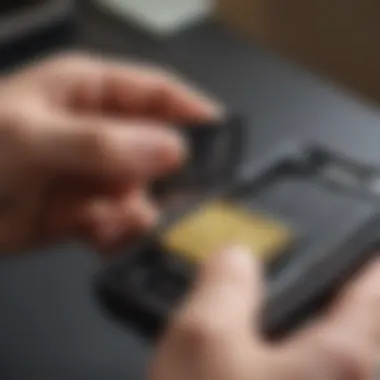How to Check If Your Phone is Unlocked: A Complete Guide


Intro
Determining if your mobile phone is unlocked is more than just a technical check. It is crucial for those wanting flexibility in choosing cellular service providers or using their devices while traveling internationally. Unlocking a phone can also have implications on its resale value and the overall user experience. This guide aims to equip you with knowledge to assess your device's unlocking status. Understanding these nuances gives you control over your communication needs and preferences.
Understanding Phone Unlocking
Unlocking a phone refers to the process of removing the restrictions imposed by a cellular carrier. A locked phone is tied to a specific carrier, limiting your ability to switch providers or use a local SIM card when traveling abroad. An unlocked device, on the other hand, provides the freedom to choose any carrier that supports the phone's technology.
Importance of Knowing Your Phone’s Status
Knowing whether your phone is unlocked can save you time and money. Here are some reasons why it's essential to understand your device's status:
- Switching Carriers: An unlocked phone allows you to switch carriers easily to benefit from better plans or services.
- International Travel: Using a local SIM card while abroad can reduce roaming costs and provide access to affordable data.
- Resale Value: Generally, unlocked phones have a higher resale value.
Understanding whether your phone is unlocked can greatly enhance your mobile experience.
Methods to Check if Your Phone is Unlocked
Check Through Your Carrier
One of the most reliable methods to see if your device is unlocked is to contact your carrier. They can provide detailed information based on your phone's IMEI number. Here’s how:
- Find your IMEI number by dialing *#06# on your device.
- Call or visit your carrier’s customer service.
- Provide them with your IMEI number for verification.
Inspect SIM Card Behavior
If you can easily switch SIM cards between different carriers, your phone is likely unlocked. Try the following steps:
- Turn off your phone.
- Remove the current SIM card and replace it with a SIM from a different carrier.
- Restart the phone.
If your phone connects successfully to the new network, it is probably unlocked.
Use Online IMEI Checking Services
Several websites offer services to check your phone’s unlocking status using your IMEI number. These services may charge a fee. Make sure to choose a reputable site. Here are steps to follow:
- Navigate to a trusted IMEI checker website.
- Enter your IMEI number.
- Pay any required fee and wait for the results.
Consult Your Device Settings
Sometimes, your phone provides information regarding its status in its settings menu.
- On Android:
- On iPhone:
- Go to Settings > About phone and look for status information.
- Go to Settings > General > About and check for carrier lock status.
Consequences of Unlocking Your Phone
Unlocking a phone can lead to several advantages and potential drawbacks. Here are considerations:
Advantages
- Flexibility with Carriers: Choose from various carriers that meet your needs.
- International Use: Easily use local SIMs when traveling.
- Increased Resale Value: Unlocked phones often sell for more.
Disadvantages
- Warranty Voids: Some manufacturers may void warranties if unlocked improperly.
- Possible Compatibility Issues: Not all phones work seamlessly with all carriers.


Closure
Checking if your phone is unlocked can seem daunting. However, there are simple methods to determine your device's status. You can enhance your mobile experience significantly by understanding whether your phone is locked or unlocked. This knowledge empowers you with choices that align with your communication needs.
Understanding Phone Locking
Understanding the concept of phone locking is crucial for anyone who uses a mobile device, especially in a world shaped by diverse carriers and networks. When a phone is locked, it is restricted to a specific carrier's network and cannot be used with others. This limitation can lead to several inconvenience, particularly for users who travel frequently or seek more cost-effective services.
Both technical and consumer perspectives reveal the nuances within this simple definition. Carriers impose these locks to ensure that devices, often subsidized, remain within their ecosystem during the service contract period. For consumers, understanding this is vital because it directly affects device usage, roaming capabilities, and potential financial implications when switching carriers.
The implications of being locked are far-reaching. Users may miss out on competitive pricing from different carriers or be bound to less than optimal service plans. Moreover, the process of unlocking is not as straightforward as many believe, and the consequences of doing it improperly can lead to device malfunction or voided warranties. The next parts of this article will delve into specifics to better inform your choices regarding unlocking your phone.
What Does It Mean to Be Locked?
A locked phone is bound to a particular carrier. This means it has software configurations that enable only specified networks to connect and authorize its use. The primary reason for locking phones is to protect investments made by carriers, especially for so-called subsidized devices. These devices are often sold at reduced prices under the condition that the customer commits to a contract for a set duration.
Being locked affects different functionalities. For instance, a locked phone may restrict the user from switching to a different carrier when a better deal is available or when traveling abroad. This not only limits personal choices but can also lead to higher costs if international roaming fees apply.
Benefits of Unlocking Your Phone
Unlocking a phone brings a variety of benefits that can enhance user experience and optimize performance. One primary advantage is the freedom to choose any compatible mobile network. This can often lead to savings on monthly bills, as users can shop around for better rates or promotions from different carriers.
Furthermore, an unlocked phone can improve its resale value. Potential buyers typically prefer unlocked devices, as they offer flexibility. Travelers find it particularly beneficial since they can switch to local carriers to avoid exorbitant roaming fees. By using a local SIM card, users can access reliable network services at affordable rates.
- Flexibility: Switch carriers when needed.
- Cost-Effective: Avoiding high roaming charges while traveling.
- Higher Resale Value: Enhanced demand in the second-hand market.
Common Myths about Locked Phones
Many misconceptions surround the idea of locked phones. One prevalent myth is that locked phones are fundamentally inferior to their unlocked counterparts. This is not entirely true. Locked devices can be fully functional and capable of delivering excellent performance; their primary limitation is network access.
Another misunderstanding is that unlocking a phone is a simple process or requires complex technical skills. While many devices can be unlocked through carrier guidelines or services, the difficulty may vary. Misleading information often circulates about the consequences of unlocking, such as the belief that doing so automatically voids warranties. Many manufacturers have policies that support unlocking under specific conditions.
Determining whether your phone is unlocked is an essential aspect for individuals looking to use their device with different carriers. Understanding the unlocking status enables users to switch service providers or use their phone abroad without issues. It is crucial to know this information as it provides flexibility and often results in cost savings. Here, we will explore various methods to check your phone's unlocking status.
Using Carrier Codes
Carrier codes provide a straightforward method for users to check their phone's unlock status. Each carrier has unique codes that can be dialed to retrieve information about the device. Typically, dialing a specific sequence brings up a menu or message indicating whether the phone is unlocked.
For example, AT&T users can dial to determine their call forwarding status, which indirectly indicates whether the device is locked. It is critical to check with the specific carrier for the relevant code.
Steps to Use Carrier Codes:
- Obtain the correct carrier code for your service provider.
- Dial the code on your phone's keypad.
- Follow any on-screen prompts or messages.
Testing with Different SIM Cards
Another effective method to check if your phone is unlocked is by testing it with different SIM cards. This method involves inserting a SIM card from a different carrier into your device. If the phone connects to the network, it indicates that the device is unlocked. If it shows an error message or does not connect, the phone is likely still locked.
Testing Steps:
- Power off your phone.
- Eject your current SIM card and insert a different one.
- Power on the device and observe the network connection.
This method is practical and commonly used, as it provides direct results without much technical knowledge.
Using Device Settings
Many devices have built-in menus that can help you ascertain if the phone is locked. By navigating through the settings, you may be able to find the carrier information or the lock status directly. This method varies among different phone brands.
How to Check the Settings:


- Open the settings menu on your device.
- Look for the 'About Phone' or 'Status' section.
- Check the network status or carrier information for any indications of being locked.
This option works best for individuals who prefer on-device solutions without using external tools.
Online Unlock Status Checkers
For those preferring an automated solution, using online unlock status checkers can be helpful. Several websites allow users to check their phone's lock status by inputting the device’s IMEI number. Make sure to use reputable websites to avoid security issues.
Steps to Use Online Checkers:
- Locate your device’s IMEI number (usually found in the settings or by dialing ).
- Visit a reliable unlock status checking website.
- Enter your IMEI number and follow the prompts to check your unlock status.
These services can offer quick results but be wary of potential fees or inaccuracies.
To summarize, checking if your phone is unlocked involves multiple methods including carrier codes, testing with various SIM cards, using device settings, and online unlock checkers. Each method has its advantages and caters to different preferences.
What to Do If Your Phone is Locked
When you discover that your phone is locked, it is crucial to understand the subsequent steps you can take. A locked phone restricts your ability to switch carriers or use local SIM cards when traveling. Thus, addressing this issue becomes a priority for anyone who desires flexibility in mobile services.
Contacting Your Carrier
One of the first actions you should pursue is contacting your carrier. Each carrier has unique processes for unlocking phones. Typically, they will require your IMEI number, which you can find in the settings of your device or by entering *#06# on your phone. You can also find it on the back of the device or in the original packaging. Communicating directly with them can reveal your eligibility for unlocking based on your account history and the specific policies the carrier has.
It's advisable to be persistent and detail-oriented in your conversations with customer service representatives. Expect a few questions regarding your account status. They may inquire about your device's purchase date, the regularity of monthly payments, or whether the phone has been reported as stolen.
Understanding Unlocking Policies
Before engaging in the unlock process, familiarize yourself with your carrier's unlocking policies. Each provider has its terms, which may vary significantly. Some common elements to consider include:
- Time Period: Many carriers require that the phone be active on their network for a certain period before unlocking is permitted.
- Payment Obligations: Ensure that all payments related to the phone, including any installment plans, are fulfilled.
- Account Status: Carriers typically will not unlock phones if the account has outstanding balances or is flagged for fraud.
Understanding these policies is essential, as they dictate whether you can proceed with unlocking your device or if additional actions are necessary.
Fees and Charges for Unlocking
When you approach the unlocking process, be prepared to encounter potential fees. Some carriers will charge an unlocking fee, while others may provide this service for free under specific conditions. If fees are applicable, make sure to inquire about:
- The Fee Amount: Different carriers tend to vary in the amount charged for unlocking services.
- Payment Methods: Know how you can pay these fees, whether by a credit card over the phone or through an online transaction.
- Refund Policies: Always ask if the charge is refundable under particular circumstances, should you face unique issues in the unlocking process.
Important: Always check for promotional periods when your carrier might waive fees for unlocking.
Navigating these elements with care will help facilitate a smoother unlocking process for your phone, allowing you to enjoy increased freedom in your mobile choices.
The Process of Unlocking Your Phone
Unlocking a phone is a significant step for many users. It provides freedom to switch carriers, gives access to better plan options, and allows for international travel without being tied to a single provider. Understanding the process is critical as it ensures that users approach unlocking their devices correctly. This section covers essential aspects of this process, including how to gather needed information, the importance of manufacturer guidelines, and exploring third-party services.
Gathering Necessary Information
Before proceeding with unlocking, it is crucial to collect the necessary information about your device. This includes the phone's International Mobile Equipment Identity (IMEI) number, account details from your carrier, and any other relevant documentation. The IMEI can be found by dialing *#06# on your device, or it may be listed in the settings under 'About Phone'. Providing accurate information is essential, as incorrect details can lead to complications in the unlocking process. Ensure you also have your phone's model and make on hand, which can influence the unlocking methods available.
Following Manufacturer Guidelines
Each mobile manufacturer has specific procedures for unlocking their devices. Adhering to these guidelines is critical to avoid voiding any warranties or damaging your phone. For example, Apple, Samsung, and Google all have distinct unlocking processes. It's advisable to visit their official websites or customer support for precise instructions. This careful approach can help in avoiding unnecessary issues that may arise from incorrect attempts at unlocking. Furthermore, knowing the terms and conditions tied to your purchase can help clarify how to unlock your device appropriately.
Using Third-Party Services
Sometimes, directly contacting your carrier or following manufacturer guidelines may not be feasible. In such cases, third-party unlocking services can be a viable option. These services may offer quick solutions but should be approached with caution. Research the reputation of any service, read reviews, and understand the fees involved. While many third-party services are legitimate, some can pose risks to your device’s functionality or security. Always weigh the risks against the convenience they offer, ensuring that you choose a reputable service to avoid future complications.


Important Note: Always prioritize official channels for unlocking your device, as this minimizes risks associated with your phone’s functionality or warranty issues.
Implications of Unlocking Your Device
Unlocking a mobile phone is more than just a simple process; it comes with various implications that users should consider. Understanding these implications is crucial for making an informed decision about whether or not to unlock your device. By doing so, you can leverage many potential benefits while being aware of any drawbacks.
Compatibility with Other Carriers
One of the primary benefits of an unlocked phone is the flexibility it provides in terms of carrier compatibility. With an unlocked device, you can choose from a wider range of service providers. This means you can shop for the best deals based on your needs or travel requirements. If you’re planning to go abroad, an unlocked phone allows you to purchase a local SIM card, often resulting in significant savings compared to roaming fees.
However, not all carriers use the same network technologies. Users must check whether their unlocked device is compatible with the new carrier's network. For example, GSM and CDMA are two major types of networks. Most unlocked phones support GSM networks, commonly used by carriers like AT&T and T-Mobile. If you plan to switch to a provider that operates on a different network type, you may face challenges.
So, before making a switch, consider the following points:
- Ensure the new carrier uses a compatible network technology.
- Research the frequency bands supported by your unlocked device.
Impact on Warranty
Unlocking your phone can also have implications for your device's warranty. Manufacturers often state that unlocking your device could void your warranty. This is particularly important to keep in mind if your phone is new or if you expect to need repairs or service.
Not all manufacturers enforce this rule strictly, but it is a potential risk. Depending on the situation, if your device suffers hardware failure and the manufacturer identifies that it has been unlocked, they may refuse to provide support or warranty service. Users should review their warranty terms to understand the potential consequences of unlocking.
To summarize:
- Confirm warranty conditions with the manufacturer.
- Consider potential repair costs if warranty is voided.
Overall, understanding the implications of unlocking your device aids in making strategic choices that align with your needs and preferences.
Secure Your Phone Management Post-Unlocking
Once your phone is unlocked, it is essential to manage its configurations and usage effectively. Proper management ensures that you take full advantage of your device's capabilities and that your personal information remains secure. This section will explore the key components of effective phone management post-unlocking, particularly focusing on software updates and monitoring SIM card usage.
Updating Software and Firmware
Regularly updating your phone’s software and firmware is critical after unlocking. These updates often include security patches that protect your device from vulnerabilities. If you have switched to a new carrier, your phone may receive updates that are tailored for that specific network, enhancing connectivity and overall performance.
To check for updates:
- Open the settings app.
- Navigate to the software update section. Depending on your phone brand, this might vary. For Samsung phones, this is usually found under 'About Phone.' For Apple devices, it is under 'Settings' > 'General' > 'Software Update.'
- Click on check for updates. If an update is available, follow the prompts to install.
Staying updated not only improves your user experience but also enhances the security of your device. Ignoring updates can make your phone susceptible to various security threats. Moreover, new features and improvements are often included, which can enrich your experience.
Monitoring SIM Card Usage
After unlocking your phone, monitoring SIM card usage becomes pertinent, especially if you plan to use different SIM cards. Understanding how data and call patterns can change with different carriers is important for budget management.
To monitor your SIM card usage effectively:
- Use data tracking apps. Many phones have built-in features, but there are third-party apps available that provide deeper insights into your usage.
- Regularly review your usage. Keep an eye on how much data you consume, as excess charges can accrue quickly.
- Be aware of roaming charges. If traveling, ensure you understand the international rates associated with your selected SIM card to avoid unexpected costs.
Managing your phone post-unlocking plays a crucial role in ensuring that your device operates smoothly and securely. It enhances user experience while protecting your personal and financial information.
The End
Understanding whether your phone is unlocked is crucial for making informed decisions about your mobile experience. The ability to use your device with different carriers can provide financial benefits and flexibility. This article has explored various methods for checking if a phone is unlocked, emphasizing practical approaches such as utilizing carrier codes, testing with different SIM cards, reviewing device settings, and employing online unlock status checkers. Each method offers its distinct advantages and can cater to different user preferences, making it easier for individuals to find the most suitable option for their needs.
In addition, we discussed the potential next steps if a phone is found to be locked. Contacting the carrier, understanding the unlocking policies, and being aware of any fees involved are essential factors to consider in this process. Knowing these aspects enables users to navigate the world of mobile phones more efficiently.
Unlocking a phone can imply significant implications regarding compatibility and warranty. Thus, it is imperative to weigh these considerations carefully after confirming the unlocking status. This awareness helps users avoid unnecessary complications in the future.
Summary of Key Points
- Knowing if your phone is unlocked can expand your options for carriers.
- Methods to check unlocking include carrier codes, SIM card tests, settings checks, and online tools.
- If your phone is locked, reaching out to your carrier and understanding their unlocking policies are essential steps.
- There may be fees associated with unlocking your device, which should be factored into your decision.
- Compatibility issues and warranty concerns related to unlocking should be well understood before proceeding.
Final Thoughts on Unlocking
Unlocking your phone is a valuable action that can significantly enhance your mobile experience. It allows for more flexibility in terms of choosing carriers and using your device internationally. However, before deciding to unlock, you should evaluate your specific needs and any restrictions your current carrier may impose. Keep an open mind but be informed about the potential costs and consequences. Ultimately, an unlocked phone opens up many possibilities for users wanting to maximize their device's utility.



